I always forget how slow winter can be. It’s almost unfair, really, to have any month follow the craziness of hand over fist sales of December. We go from being unnaturally busy, from the moment the door opens, to the slowest month of the year. It’s just unfair.
One of the great things about the store being slower is I can actually get things done. Things that tend to get put off for another day. Things like deep cleaning. This needs to get done, but can only really happen when the store is not full of customers. It’s not sexy, but it’s part of the job. Other mundane things like trying to organize the back room can happen. Of course our back room was organized (bless my staff) and then I went and messed it up by trying to organize returns.
Returns are an early winter ritual. After the decimation that is the holidays, I see shelves with breathing room and I like it. I also get a real sense of what’s just not going to sell. For us, it’s hardcover books about politics and economics. Doing returns when the store is slower means it’s easier to make massive piles throughout the store based on publisher. I know other stores actually print out lists of books that haven’t sold in a X amount of time. I take a much more anecdotal approach. I examine a certain section and look to see which publishers seem over-represented. Then I decided which publisher I should train my eye on, based on number of books I see that could go, and which publisher I need credit from. Then I go through the whole store looking for books from that publisher. I look at each book that’s on the return bubble and I play this game: would I miss it if it weren’t here? Conversely, am I sick of looking at it? If I answer these questions with no or yes, then in the return tub it goes. Then I check each title for its return status. It’s actually shocking just how fast books go out of print; this just reinforces that returns need to happen more often, or you miss the window.
Doing returns in January and February can help close the cash flow gap of the slower seasons. Of course, publishers hate returns, and in a perfect world, every book I buy would be a winner, but that’s just not the case. Mistakes abound: hardcover picture books with adorable bears just don’t sell at the rate I buy them, too many 100th day of school books (does that day really get celebrated?), and one too mNY young adult hardcovers about the girl with challenges triumphing against the odds of the drunken mom, the absent father, and her eating disorder. These books have to go. Not just because they’re not good books, but because they are money sitting on the shelf and often it’s money bookstores don’t have in January or February.
The other thing that returns do is it readies the store for the new spring books. It’s a sort of out with old, in the new scenario. There is something wonderfully satisfying about knowing that your shelves truly reflect what you want to sell, not just what you happen to have on hand. Inventory control is a fun balancing act, and doing returns allows me to correct the wrongs.
As much as I like doing returns, I can’t wait to get these snowstorms and below freezing weather to turn towards Valentine’s books and Easter Bunnies in the coming months.
Saluting the Undersung: Gerald Morris
Elizabeth Bluemle - February 3, 2011
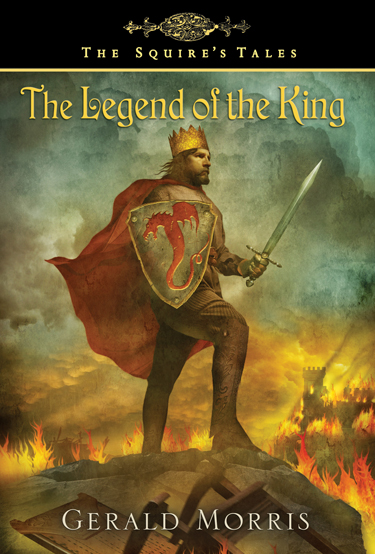 I sometimes think that writers who have carved out their own special niche are somehow bypassed by awards committees. How is it that a sparkling talent like Gerald Morris has never won a Newbery or Printz Award or Honor for his nearly flawless retellings of King Arthur legends? He’s made the Best Books for Young Adults lists a few times, and has been on state award master lists, but someone this consistently good should be as widely known and heralded and read by kids as, say, Susan Cooper, whose genius has been critically noted and rewarded, and Rick Riordan, an author whose books I also love and who has been discovered by the wider public.
I sometimes think that writers who have carved out their own special niche are somehow bypassed by awards committees. How is it that a sparkling talent like Gerald Morris has never won a Newbery or Printz Award or Honor for his nearly flawless retellings of King Arthur legends? He’s made the Best Books for Young Adults lists a few times, and has been on state award master lists, but someone this consistently good should be as widely known and heralded and read by kids as, say, Susan Cooper, whose genius has been critically noted and rewarded, and Rick Riordan, an author whose books I also love and who has been discovered by the wider public.
 Gerald Morris is a comfortable master of storytelling. You know you’re in excellent hands from the first sentence of every book, the way you do with writers like Richard Peck and Lloyd Alexander. Morris makes Arthurian legends funny and full of freshness and life while staying true to their origins; he makes structure and pacing seem effortless; and his language is delightful and rich without being at all precious. The characters are so well drawn, so wonderfully and warmly rendered, that they come to feel like old friends. Above all, Morris has a lighthanded playfulness and clarity of expression that are marvelous to read, in a moral framework that inspires integrity, honor, honesty, kindness, and effort, while gently acknowledging human frailty and celebrating joy and redemption. Not too shabby.
Gerald Morris is a comfortable master of storytelling. You know you’re in excellent hands from the first sentence of every book, the way you do with writers like Richard Peck and Lloyd Alexander. Morris makes Arthurian legends funny and full of freshness and life while staying true to their origins; he makes structure and pacing seem effortless; and his language is delightful and rich without being at all precious. The characters are so well drawn, so wonderfully and warmly rendered, that they come to feel like old friends. Above all, Morris has a lighthanded playfulness and clarity of expression that are marvelous to read, in a moral framework that inspires integrity, honor, honesty, kindness, and effort, while gently acknowledging human frailty and celebrating joy and redemption. Not too shabby.
His books usually earn 9+’s on my own personal 1-10 scale and have even earned that rare and wonderful thing, the perfect 10 (The Savage Damsel and the Dwarf, for instance, is one of the 10s).
I am not the only fan, of course. Many, many people have discovered these books via passionate booksellers (and teachers and librarians and parents, etc.). They are easy handsells* and 100% loved by whole families of customers. I’ve never met a single reader who wasn’t delighted and enriched by reading the Squire’s Tales series. That is no simple feat, my friends, and I can’t help wondering what on earth keeps this writer from winning major national awards?! How many authors are that consistently good, book after book? And yet … no gold.
I secretly hoped January 2011 might herald the Year of Gerald Morris, that he might take home a shiny medal, especially because, with little fanfare or public grieving, the Squire’s Tales series was brought to conclusion in 2010 with its 10th and final volume, The Legend of the King. Gerald Morris is one of the great American storytellers, and by gum, he deserves a great big old thank you for adding so richly to children’s literature.
 So — I am now awarding Gerald Morris the first ShelfTalker SUNG Award (short for Saluting Undersung Neglected Geniuses). Release the bards and raise your voices!
So — I am now awarding Gerald Morris the first ShelfTalker SUNG Award (short for Saluting Undersung Neglected Geniuses). Release the bards and raise your voices!
Mr. Morris himself would likely be modest and embarrassed to be singled out for this kind of attention. According to everything I’ve read, he writes children’s books for the love of it and to support his other life as a minister. Here’s a great tidbit from the autobiographical note I found on the Children’s Literature Network’s website, which in turn credits the original source: “An earlier form of this autobiographical essay appears in the Ninth Book of Junior Authors and Illustrators, edited by Connie C. Rockman, and published by H.W. Wilson in 2004.” Mr. Morris says:
“Now I am a part-time associate pastor in a Methodist church in Wausau, Wisconsin, writing children’s novels to support my ministry habit. Often the people I meet in one of my worlds are shocked to hear about my other. Literary people who find out I’m a minister are frequently astonished. (“How interesting!” they say doubtfully, as if they had just discovered that I lived entirely on a diet of worms.) On the other hand, many church people disapprove of my novels, which are full of sorcery and beheadings and fairies and elves and other things that you hardly ever find in Sunday School literature. I’m not what anyone in any of my worlds expects me to be.”
I love that.
And I love these books. Please feel free to share your own Gerald Morris affection, and herald your own undersung heroes of children’s literature.
P.S.
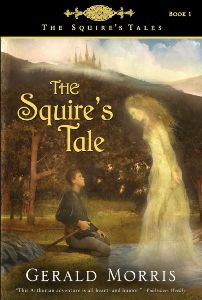
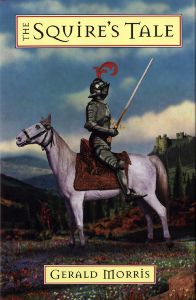 * About the handselling asterisk: the books are easy handsells as long as you don’t start off by showing kids the covers. They used to have art that indicated the books’ high adventure and hearty humor. The series look was redesigned and now features muted covers (whose black spines are difficult to differentiate among on the shelves, especially with the subtle font color) that—while handsome—often project an ethereal, sometimes melancholy tone. (The latest volume’s cover, The Legend of the King, suits the story well, I must say.) Boys often resist the first book because it looks too romantic and passive. The original version, with the knight sitting backward on his horse, was truer to the spirit of the book, and I keep a hardcover on hand at all times to show kids considering the series. Works like a charm. You only need to handsell the first one, anyway; after that, the readers come back for more and couldn’t care less what the covers look like.
* About the handselling asterisk: the books are easy handsells as long as you don’t start off by showing kids the covers. They used to have art that indicated the books’ high adventure and hearty humor. The series look was redesigned and now features muted covers (whose black spines are difficult to differentiate among on the shelves, especially with the subtle font color) that—while handsome—often project an ethereal, sometimes melancholy tone. (The latest volume’s cover, The Legend of the King, suits the story well, I must say.) Boys often resist the first book because it looks too romantic and passive. The original version, with the knight sitting backward on his horse, was truer to the spirit of the book, and I keep a hardcover on hand at all times to show kids considering the series. Works like a charm. You only need to handsell the first one, anyway; after that, the readers come back for more and couldn’t care less what the covers look like.
Igloo Reading
Elizabeth Bluemle - February 1, 2011

Fourth-grader, cozy in igloo, reads Barbara O'Connor's HOW TO STEAL A DOG. Photo credit: Katarina Krek.
Here’s a new take on curling up with a favorite book on a snowy day: build an igloo. I love this picture beyond reckoning. It’s a fourth-grader happily nestled in a snow fort, reading Barbara O’Connor‘s delightful How to Steal a Dog, oblivious to the outside world. (The reader’s mom sent the photo to Ms. O’Connor after a school author visit.)
Isn’t that what a great book does? Absorb you so deeply you aren’t aware of anything around you but the world of the story? Susan Cooper captured that absorption perfectly in Dreams and Wishes: Essays on Writing for Children (p. 24, if you want to know):
Watch the child reading a book: really reading, totally caught up in the world into which the words on the page have transported him…. He is sprawled or curled or propped in some inelegant position, face concentrated and intent, motionless; he isn’t with you any more. He doesn’t hear you when you call; he doesn’t notice that the sun has set and that he should turn on the light. He’s away out there with the author, in wonderland.
Someone needs to contact the photographer to make this into a reading poster pronto. Really. It’s iconic.
Since we’re expecting a giant dumping of snow tonight and Wednesday, I invite you to send me your photos of snowy-day reading. I’ll post the best ones here.
A Quick Way to Leave Work
Josie Leavitt - January 31, 2011
Readers of ShelfTalker by now should know what a sucker I am for a cute puppy, or any dog for that matter. I love to hold them while their owners bustle about the store. This usually goes without incident, except for Friday.
I was having a very productive day doing returns when Shelby (not her real name) came in with her family. Shelby is a year-and-a-half-year-old dachshund who was in the arms of her owner. Just the other day I had seen and held  Shelby without incident. This day, however, Shelby was very excited to see me. Just as I held her close, the way she had liked the day before, Shelby peed all over me. Not just a little that could be washed off easily, but a lot. Enough so that my shirt was soaked and even my jeans had not escaped this very excited dog, who apparently hadn’t gone to the bathroom all day. We were all embarrassed. Shelby looked pitifully guilty, her owner kept apologizing and I wondered why I never left a change of clothes at the store.
Shelby without incident. This day, however, Shelby was very excited to see me. Just as I held her close, the way she had liked the day before, Shelby peed all over me. Not just a little that could be washed off easily, but a lot. Enough so that my shirt was soaked and even my jeans had not escaped this very excited dog, who apparently hadn’t gone to the bathroom all day. We were all embarrassed. Shelby looked pitifully guilty, her owner kept apologizing and I wondered why I never left a change of clothes at the store.
I emailed my Simon & Schuster rep and explained that I needed to reschedule my phone appointment. In my email I explained what happened. Then I thought maybe I should call him, just in case he didn’t check his email. He was still laughing when he picked up the phone. I was happy to provide “the funniest thing” he’d ever heard. I know it’s just an excited puppy, but getting pee all over me was not how I wanted to spend part of any day. It occurred to me, maybe this was an elaborate ruse from the publishers to get me to stop doing returns.
I drove home, damp and a little smelly with a new adage forming in my head: Just because a puppy is happy to see me doesn’t mean I should pick her up.
Actually Ironic
Elizabeth Bluemle - January 28, 2011
Fun for a Friday morning: I can’t resist sharing this with you caretakers of language. CollegeHumor.com has taken on the Alanis Morrissette song, “Ironic,” and given it lyrics that are in fact ironic, instead of merely unlucky. (There are a few examples I would still quibble with; even the CollegeHumor people had trouble with the “free ride” and “good advice” lines. All in all, however, an excellent job and extremely amusing.)
An old man turned ninety-eight, he won the lottery and died the next day…of a shock-induced heart attack
It’s a black fly in your Chardonnay……poured to celebrate your apartment fumigation
It’s a death row pardon two minutes too late…’cause the governor was busy watching Dead Man Walking
And isn’t it ironic…don’t you think
It’s like rain at a dehydration victim’s funeral
It’s a free ride to your bankruptcy trial
It’s the good advice to never listen to me
Who would’ve thought…it figures
Mr. Play It Safe, he was afraid to fly
He packed his suitcase and kissed his kids goodbye
He’d waited his whole damn life to take that flight
And as the plane crashed down he thought
“Now I’ll never make it to that Fear of Flying seminar”
And isn’t it ironic…don’t you think
It’s like rain flooding an umbrella factory
It’s a free ride to an overpriced car dealership
It’s the good advice from the guy who just got you fired
Who would’ve thought…it figures
A traffic jam when you’re already late…to receive an award for reducing automobile congestion
A no-smoking sign on your cigarette break… at the R.J. Reynolds tobacco company
It’s like ten thousand spoons when all you need is a knife…to rob a soup kitchen
It’s meeting the man of my dreams, and then meeting his beautiful wife…who’s also my relationship therapist
And isn’t it ironic…don’t you think
A little too ironic…yeah, I really do think…
It’s like rain on your wedding day…to the Egyptian sun god Ra
It’s a free ride when you’ve already paid…for a stolen car
It’s the good advice someone advised you not to take
Who would’ve thought…it figures
I have a funny way of defining rhetorical devices that I use in songs
Songs have a funny, funny way of getting things wrong
Getting things wrong
Working Together…With Beer
Josie Leavitt - January 27, 2011
One of the great things about last week’s Winter Institute was getting to know some of my fellow Vermont booksellers a little better. I spent a fair amount of time talking to Becky Dayton, owner of The Vermont Bookshop, about business and books. Yesterday, Becky emailed me about sales reps and her idea about getting reps back into Vermont.
The email from Becky was very intriguing: “I had a wacky idea of trying to organize a day of rep appointments for multiple vendors and stores in a central location. Kind of a la “speed dating,” but writing orders…” This is not a wacky idea, this is really smart business. Vermont, especially Northern Vermont, has felt the loss of in-person reps for many years now. Please know, I am not maligning the phone reps I’ve worked with, they’ve been great. But there is something about meeting face to face, preferably over a meal or coffee, that can really build a relationship that’s mutually beneficial.
Imagine, if you will, a room full of eager buyers from up to five stores in Northern Vermont, listening intently to sales reps from some of the big publishing houses: Simon & Schuster, HarperCollins, and Hachette talking about their books. Then each rep would meet with one store at time while the others mingled, had some pizza and maybe even a beer. This could turn a buying session into something fun and memorable for all involved. I have a gut feeling the orders would be larger because the buyers would be more relaxed. Plus, there is something really great about getting together with other booksellers. So often we feel like we toil in solitude, that when we can gather and share, it’s invigorating.
I have heard of some reps who have done this sort of thing, occasionally, but wouldn’t it be fun if it could be done three times a year? Pick a different store each time, different take-out, pizza, Chinese food, or sandwiches and a bunch of buyers who normally work in isolation, some in basements, actually getting together and talking to peers about books. Not only could they talk about books, but maybe event planners could come to these meetings and together they could work with publishers to bring authors to their state who might not otherwise visit. I’ve always imagined a Vermont tour that could be designed for ease of visiting as many stores as possible with a minimum of fuss. The beauty of Vermont is there are very few independents close enough to compete with each other (this is especially true of Northern Vermont), so authors could conceivably spend a week driving in our lovely state, visit upwards of 10 stores and never overlap with any customer base. That’s a pretty good deal, and it’s hard to explain that to folks who haven’t already driven around our fair state.
I know that publishers are facing deep cuts and they are trying to save money by not sending reps on the road, but the lack of in-person reps affects my business. For instance, Simon & Schuster took my rep away and then I bounced around last year with two different phone reps. Now, finally, I seem to have one who’s going to be my rep for a while. I like Stuart very much, but I think it would be so much more meaningful for me if I could have a coffee with him and get to know him as a person, not just the nice guy on the phone who knows books.
So, I’m hoping that the publishers will take up Becky’s idea, set a food budget, work together and let us buy our books in person again. If this happens, I’ll even buy the beer.
Getting It Done
Josie Leavitt - January 24, 2011
Winter Institute 6 may be over, but it’s having a lasting effect on me. After two sessions last Friday about efficiency, I’m raring to get stuff done, as are a lot of my bookselling friends. In fact some of us in New England have publicly stated their goals with dates, to help keep themselves on track.
How many times have you wanted to have two more hours in every day to get your work done? As booksellers, especially in smaller stores, we are interrupted literally by the business of retail: helping customers and selling books. Don’t get me wrong, this is a lovely thing, but it can make it hard to file co-op reports, plan events or do any of the myriad of tasks that small store owners or managers must do. I was in awe when one Wi6 attendee said she gets a list of books to her display manager when it’s time for a new look in the store. A display manager? Wow! I had no idea there was such a thing. I don’t have a display manager, but armed with my newly minted tools for greater efficiency, specifically from David Allen’s great workshop at Wi6, and from reading his book, Making It All Work, I can run my store as if I have one.
I have to make good use of all the time I have in a day. This actually means taking time out to plan. Imagine. Taking a deep breath and planning and not just putting out fires. Today went well. I continued clearing out my email, I’ve pared down my store in-box from just over 3,000 emails to under 20. Of course, I got 50 emails today, so clearly this is going to be a real challenge. But there was something breathtaking about seeing an in-box that was so lean. That kind of clarity makes it easier to get other things done.
Dan Cullen from the ABA mentioned the two-minute rule in his workshop: if it will take two minutes or less to do, then just get it done. Don’t put it on a list of things to get done, get it done. I tried that today and it not only worked, it made me more productive because I was able to clean out my in-box, put out a fire and plan ahead. This felt like a win-win to me.
The key to all of this is maintaining the zeal of the newly converted in a month or two. The challenge will be resisting falling back on old habits and letting things pile up. I do think it’s easier to get things done rather than thinking about getting things done.
Has anyone made any efficiency/planning goals since Wi6? If so, would you like to share what they were and what you hope to get out of them? Mine were to start planning the store’s 15th anniversary party even though it’s not until November, and to keep working on maintaining a streamlined in-box. I know that’s not horribly exciting, but I wanted to be realistic and give myself a chance of success. And you?
Bookseller Math
Elizabeth Bluemle -
 Get four booksellers in a taxi at Winter Institute and the conversation quickly turns confessional–and riotous. We compare systems, not so much for book receiving, ordering cycles, inventory control, staff training, accounting, events, or the myriad other tasks that occupy our waking hours, but for dealing with difficult customers, dropped balls, elusive books on walkabout in the store, and so forth. It became clear that we use a special kind of math in our workaday world, a unique set of
Get four booksellers in a taxi at Winter Institute and the conversation quickly turns confessional–and riotous. We compare systems, not so much for book receiving, ordering cycles, inventory control, staff training, accounting, events, or the myriad other tasks that occupy our waking hours, but for dealing with difficult customers, dropped balls, elusive books on walkabout in the store, and so forth. It became clear that we use a special kind of math in our workaday world, a unique set of  values, terms, and functions I’m calling Bookseller Math.
values, terms, and functions I’m calling Bookseller Math.
For example:
Algebra: We are constantly solving for X and Y, where X is the last copy of Rick Riordan’s The Lost Hero, and Y is the shelf it should be on but isn’t. The upside: The thrill of victory when we successfully plug in the correct values, shout “Eureka!” and hand the wrangled book to a happy customer.
Calculus: Calculus, the study of “rate of change,” is all too familiar to booksellers as we encounter new variables, limits, derivatives, and functions — on a daily basis, in infinite series. Each store assesses its domain and range, and formulates its own equations, such as f(x) = 2x, where x = the ever-increasing cost of goods sold. Or K(A)n+E÷L=F(b), where K=the Kindle, A=Amazon, n=the nook, E=the economy, L=Luddites, and F=Future of bookselling. Okay. That’s enough of that. I was an English major; the previous was the sum of my memory of calculus. The upside: It’s fun to reinvent one’s business plan again and again and again and again. We gather no moss, that’s for sure.
Negative numbers: These appear all too often as inventory on-hand quantities, caused by forgetting to finish receiving that order you’re waiting for shipping costs on, or those consignment books you put on the shelf before actually getting in the system. When we ring up those books, they are deducted from the inventory whether or not we’ve officially added the latest quantity received. Example: The computer says we have -3 copies of Young Fredle, but we ordered five last week, so there should be two on the shelf. Eureka! The upside: Negative numbers keep our brains nimble as we make lightning-quick calculations when locating books for customers.
Ratios: A matter of relationships and proportion. These are generally positive, but also involve, sadly, fractions. Of sales, in this economy and climate (see Calculus). The upside: Indie booksellers excel at relationships and try to keep our sense of proportion, even in the face of fractions.
Geometry: This is the study of shape, though it’s not quite clear whether our area of concentration rests mainly with our stores (displays, the task of fitting too much into too little space, predicting the relative stability of book stacks, etc.) or ourselves (the direct correlation of desk time to bookseller bottom size). The upside: Remembering that perspective is a key element of geometry.
∏: What we need when we’re done worrying about the above.
WI6, The Second Day
Josie Leavitt - January 21, 2011
Yesterday started with a full breakfast before the speaker, and that was a good thing as Bob Phibbs, the Retail Doctor, had a lot of energy for so early in the day. I must admit, at first I was thinking that it was too loud and silly, as he had us blowing up balloons and making paper airplanes, and we watched as he squished a piece of perfectly good chocolate cake. But his message was right on target.
He talked about how Steinbeck’s The Red Pony opened his imagination, and that’s what booksellers do: we connect folks to their imagination. He also did something I really loved — he told us to stop whining about Amazon (there’s been a lot of that this week). People want to make connections with real people, so it’s our job to make those connections and value them. His description of staffers, “Bitter Betty” and the slacker guy behind the counter, and how their behavior can actually have p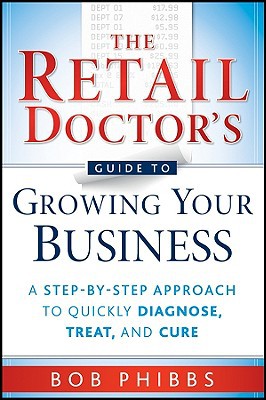 eople decide not to return to your store ,was mind-opening. Have fun! Make displays that make people laugh. Oh, what a great concept.
eople decide not to return to your store ,was mind-opening. Have fun! Make displays that make people laugh. Oh, what a great concept.
Don’t be afraid of customers with Kindles, Nooks or iPads, just get them in your store and create such a positive experience they want to come back. He ended by saying for us to stop complaining and frame things in the positive: what have you done right, and what two things will we commit to doing to help our store. I think the free copy of his book will be invaluable, and that’s the way I want to start my day.
After that I went to The New Reality: Alternative Business Models for the Independent Stores, which, while very interesting, was more of an events workshop, rather than showing me a way to market my store or show me what else I can add to the book mix to increase my sales. That said, I did learn about some great events. Annie Philbrick of Bank Square in Mystic, Conn., started having author lunches, rather than evening author events. Her town is a lot like mine, it goes to bed early. She found that by charging for the book, it ensured an audience for the lunch. Co-op money covered the cost of the food, which was sponsored by a local eatery. So, 30 or so people would come to lunch, guaranteeing sales of at least 30 frontlist hardcovers, they’d have lunch on their laps in the store and have a very intimate time with an author. The lunch took the stress out of wondering just who would come to an evening event. It was a win-win for all involved.
Jane Streeter of The Bookcase in Nottinghamshire, U.K., started a film and book festival in her town of 2,000. This has been hugely successful and has expanded out to other towns and now includes showings of first-run movies, with the store providing books that relate to each film, dozens of author signings and an actual festival on the village green.
Nancy Simpson of The Book Vault in Oskaloosa, Iowa, started Day for Divas with six other independent stores in her downtown. Women (they’re working on something for men) buy tickets for $25 and it includes a cooking demo, something fun at the nail salon, lunch and a bunch of other things.
One great thing I learned from this is ridiculously simple. Ask a visiting author in advance of their visit what their favorite book is and have it on hand when during the visit. It’s an easy way to sell backlist, and usually unexpected backlist.
Other folks commented that they are now offering classes. They partner with a teacher, be it for languages or knitting, they keep the class sizes small, ask for pre-payment as way to ensure their place in the class, and the classes are selling out. Working with a teacher can help bring new customers to your store, while ensuring a revenue stream.
Next up was the Speed Dating with reps at lunch. At least this year everyo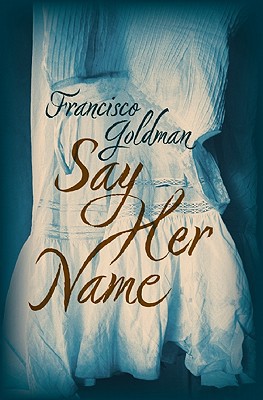 ne ate before the reps started talking about their books and passing them around. I must be getting older, but I find it hard to concentrate at these lunches because there’s just so much ambient noise. I feel bad for the hard-working reps, or publishers who are telling us about their books. I did learn a lot and am happy to have Say Her Name by Francisco Goldman in my bag to read on the plane. Morgan Entrekin of Grove Atlantic did such a wonderful job describing this book about love and loss that I just can’t wait to read it. I can say the same for Jeff Abbott’s Adrenaline presented by Mike Heuer from Hachette. I love a good mystery/thriller and he made this sound unputdownable.
ne ate before the reps started talking about their books and passing them around. I must be getting older, but I find it hard to concentrate at these lunches because there’s just so much ambient noise. I feel bad for the hard-working reps, or publishers who are telling us about their books. I did learn a lot and am happy to have Say Her Name by Francisco Goldman in my bag to read on the plane. Morgan Entrekin of Grove Atlantic did such a wonderful job describing this book about love and loss that I just can’t wait to read it. I can say the same for Jeff Abbott’s Adrenaline presented by Mike Heuer from Hachette. I love a good mystery/thriller and he made this sound unputdownable.
Then I went to What Really Drives Choice in the Children’s Book Market. The good news is bookstores (chain or indie, they were not separated in the survey) are the first place parents go to look at books. This was gratifying. But the sad part of this is only 6% of book sales occur at independents. We are below Barnes & Noble at 28%, Sam’s Club, and other bricks and mortar stores. So, at least Amazon has not figured as much we all think they have. This says to me, we’re doing a great of getting folks in the store, but maybe we need to do more to close the sale. The other bright point was teenagers don’t seem to like e-readers much. There was much more to this than my quick recap, but without access to the slides (should be coming in a few weeks) I can’t really say more.
The author reception, which I left early to do my blog before my publisher dinner (aren’t I good? actually it was more that I had reached the limit of number of galleys I could carr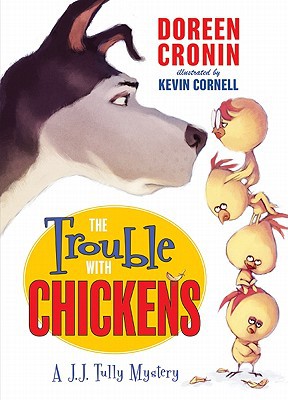 y). I love the author reception. I get to meet some old friends and say hi. Tonight I got to say “Hi!” to Doreen Cronin, whose new book, The Trouble with Chickens, looks just right for my eight-year-old nephew and all kids looking for a middle grade book that’s funny. It’s making the connections that inspire me. I got to meet first-time author Victoria Brown. Her adult book, Minding Ben, about a teenager from Trinidad who winds up as a New York City nanny, will be a great cross-over book for my sophisticated teen readers. If I hadn’t been at this event, I might well have passed on the book, but to hear her talk about it, I knew I could sell it when it comes out.
y). I love the author reception. I get to meet some old friends and say hi. Tonight I got to say “Hi!” to Doreen Cronin, whose new book, The Trouble with Chickens, looks just right for my eight-year-old nephew and all kids looking for a middle grade book that’s funny. It’s making the connections that inspire me. I got to meet first-time author Victoria Brown. Her adult book, Minding Ben, about a teenager from Trinidad who winds up as a New York City nanny, will be a great cross-over book for my sophisticated teen readers. If I hadn’t been at this event, I might well have passed on the book, but to hear her talk about it, I knew I could sell it when it comes out.
Winter Institute is so many things: camaraderie, a joint bitch-fest at times, a place where you can get reinvigorated by new ideas, meet authors old and new, generally have a good time surrounded by like-minded book lovers. It’s just a pity only 500 booksellers can come.
Off to a publisher dinner! More on Monday.
Winter Institute Thus Far
Josie Leavitt - January 20, 2011
Okay, I’ve only had one full day of Wi6 so far, but it’s been a really interesting day. Today was Legislative Day. It began with a panel discussion at breakfast-time (it struck me as odd to convene folks for a panel at 9 a.m. and not offer a stale Danish or some coffee), but the conversation was lively. The day ended with a reception at the Library of Congress; in between I was urged to action by the head of the Small Business Administration and I got to talk to my Senator’s assistant and my actual Congressman. All in all, a pretty full day.
The panelists for the first session, Indie Retail and Activism: The Business Road to Political Change, were interesting, more for the applications of common themes of 21st century retail: working locally, how to be political without giving offense, and how to advocate for your industry in a way that gets your customers to help and do most of the work. Rick Karp, president of Cole Hardware in San Francisco, Jakob Wolf-Barnett, pperations manager of Revolution Cycles, Washington, D.C and Wendy Hudson of Nantucket Bookworks were the panelists. Oren Teicher moderated the discussion. Basically, each panelist has been an advocate for their industry. While I found their individual stories interesting, I must say, after going to five other Winter Institutes, regional shows and Book Expo America, I didn’t hear anything new.
What I did hear was passion for change and that, in and of itself can make me excited to do more. Revolution Cycle’s tag line is brilliant: more butts in bikes. Short, to the point and really says it all. Jakob runs the bike store a lot like a bookstore; great, dedicated and passionate staff all working to fight the fight about why spending more for the same bike you can buy at a toy store is a great idea. One really great idea was from Rick: spend more time working on your store, not in your store. I realize that can it be hard with the many hats we all wear at indies, but you can’t really do long term planning, advocacy, or attend Local First meetings or Chamber of Commerce meetings when you’re working behind the counter or receiving shipments.
The next panel was moderated by a very funny and very knowledgeable Jim Lehrer. He interviewed Karen Mills who’s the head of the SBA. His questions were insightful and broad: “What can the SBA do for bookstores?” It may sound silly, but there weren’t many of us who knew just what they offered for the small business. And the running joke was there should be a Tiny Business Administration (when I was meeting the Leahy staffer, he said, “it should actually be the Micro Business Administration because so many businesses are so small”). As soon as this session was done, I ran back to my room to go to the SBA’s website to see what I credits I could claim on my taxes and what loans could be available to me. I was encouraged by the degree of help available that I didn’t know about.
Lunch was boxed and uneventful. I had neglected to check the box the allowed my access to my representatives, but Penny and Liza from the Norwich Bookstore graciously allowed to tag along with them. I must confess, I’m not usually dumbstruck, but a giddiness over took me as we entered the Senate building on our way to meet with Senator Leahy’s staff. I kept thinking as I looked at the offices, many of whom were being redecorated for the incoming, newly elected Senators, these are Senator’s offices. This is where laws get made, this is a place that exudes power. I kept thinking about all the television shows I’ve seen about Washington, and here I was walking the halls of the Senate building looking for an office. It was quite awe-inspiring.
To be able to speak directly to a Senator’s assistant, or the an actual Congressman, as was the case with Peter Welch, was quite moving. To have someone in an actual position of power listen to us vent about tax fairness and credit card fees was really amazing. We were given websites and names of people we could speak with when we got home to keep the ball rolling. Then we went to the House Gallery to listen to Congressmen give testimony about the health care debate, which was quite extraordinary.
One of the best parts of the day was having coffee with Liza and Penny talking about bookselling. So often we work in isolation, and to be able to discuss the finer details of the business with fellow colleagues is a joy.
More tomorrow, about today’s educational sessions.
